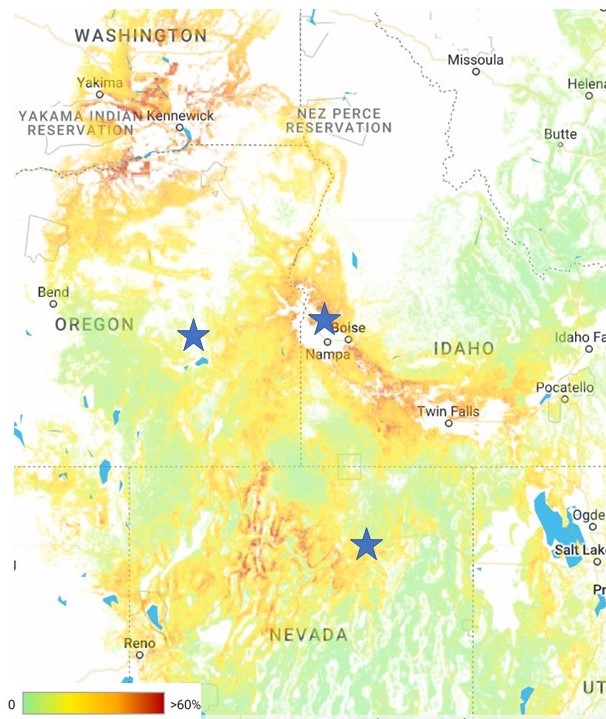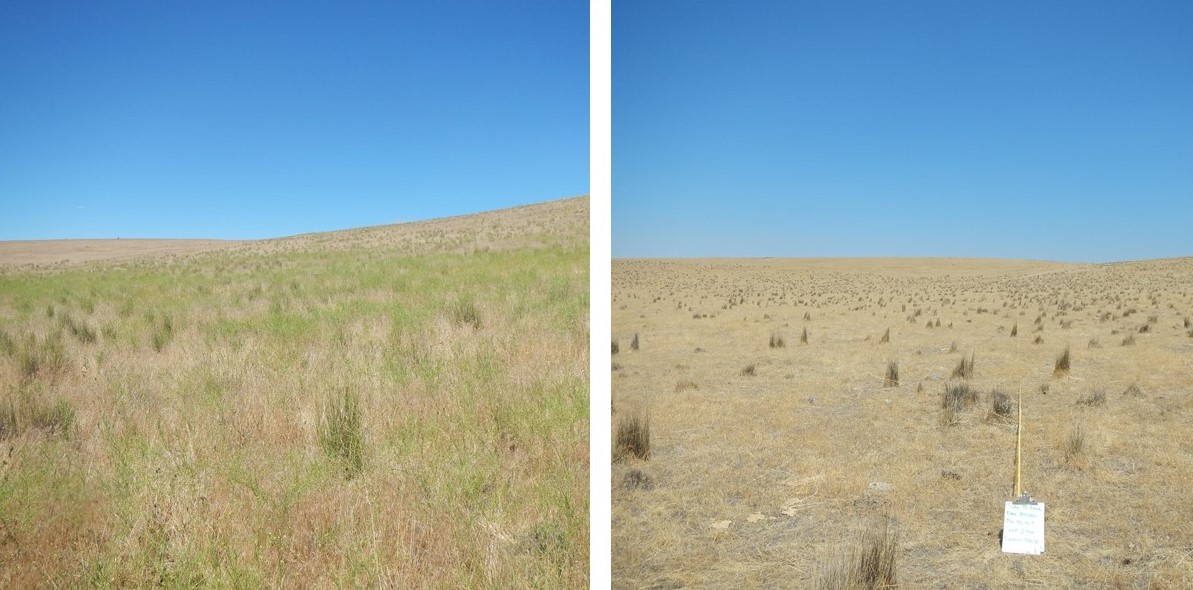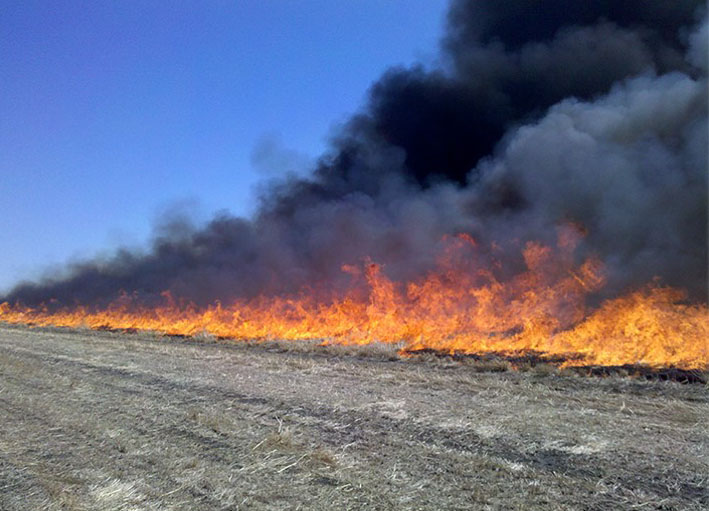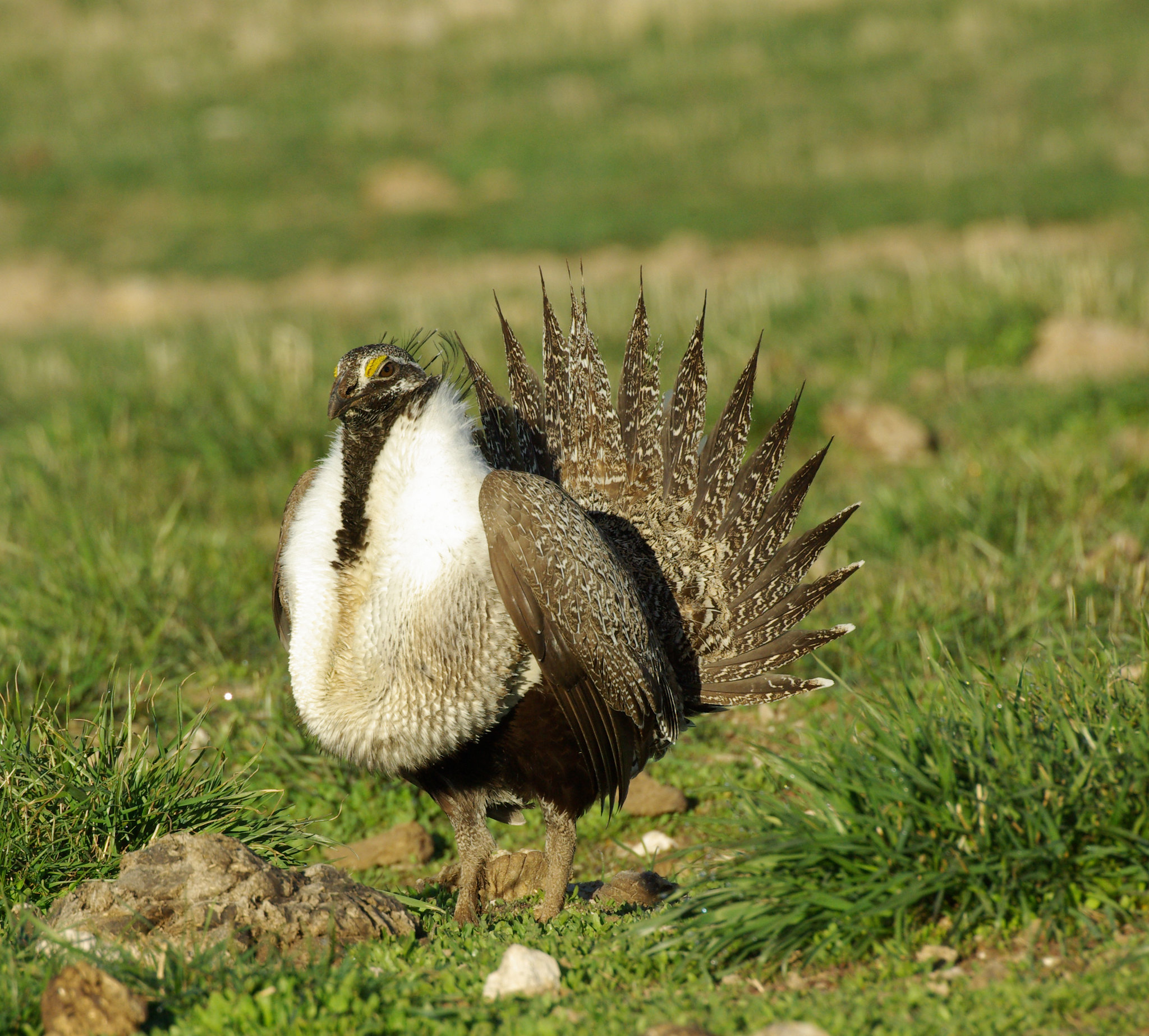Climate change has heightened the risk of large and frequent wildfires in the Great Basin, and caused the region to enter a new era of megafires—fires that burn 100,000 acres or more. As a result, rangeland and fire managers will need management practices that can protect property, wildlife habitat, and resources from wildfire. Targeted cattle grazing could provide one such management practice. Rangeland scientist Pat Clark and his team at the Agricultural Research Service have worked with partners to implement targeted cattle grazing to create effective wildfire fuel breaks on public rangelands.
Reading Time | 9 minutes
Management Goals | Use targeted cattle grazing to create wildfire fuel breaks while avoiding grazing-related damage to rangelands.
Audience | Ranchers, Rangeland Managers, Fire Managers
Project Contact | Pat Clark
Project Area | Northern Great Basin with nine sites in Idaho, Oregon, and Nevada
Funding | See funding section
Cattle grazing can be used to create fuel breaks, which are strips or blocks where vegetation has been minimized or removed to slow the spread of wildfire, making it easier and safer for firefighters to combat wildfires. There are many ways to create fuel breaks, including prescribed burns, chemical treatments, and mechanical treatments (e.g., mowing, dozing). However, some of these methods can be cost-prohibitive or difficult to maintain. Targeted grazing, which uses cattle to eat large strips of flammable vegetation down to a targeted stubble height in the spring, is a sustainable alternative. As such, Pat Clark and his team determined that implementing such targeted cattle grazing fuel breaks in the Great Basin could help prevent the spread of wildfire.
Invasive annual grasses and climate change are increasing wildfire size and frequency
The spread of invasive annual grasses is one of the main contributors to increased fire size and frequency in the Great Basin. Cheatgrass (Bromus tectorum) and medusahead (Taeniatherum caput-medusae), two of the most common invasive annual grasses, grow rapidly in spring and die early in summer, covering rangelands in dry vegetation which can easily ignite and spread wildfire. Climate change has increased temperatures and reduced snowpack, expanding the range of these highly flammable grasses. As of 2020, invasive annual grasses dominate one-fifth of Great Basin rangelands, an eight-fold increase from 1990. Areas with invasive annual grasses burn 2–4 times more frequently than areas that are not dominated by annual grasses in the Great Basin. By using cattle to create fuel breaks in these swaths of invasive annual grasses, rangeland managers could help to prevent more wildfires from turning into megafires.
Targeted grazing can create fuel breaks to reduce fire intensity and spread
Site and Permittee Selection
To begin this project, Pat Clark and his team located areas in the Great Basin that might be appropriate for the implementation of targeted cattle grazing for wildfire fuel breaks. The team selected locations based on the following factors:

- Potential to protect resources like infrastructure and fragile habitat.
- Safe and effective for cattle grazing.
- Grazing would not cause negative effects on desirable plants and other ecological features. Site locations already contained annual grasses.
- Located in a spot that frequently experienced fire.
Using these criteria, sites were selected throughout the northern Great Basin, including a site near Boise, Idaho, Frenchglen, Oregon, and Elko, Nevada. Scientists and managers then visited sites to assess and record conditions before treatment, including vegetation cover, height, composition, and inter-canopy gaps.
While other options for creating fuel breaks can be cost prohibitive or difficult to maintain over time, Clark notes that “cattle can create and maintain protective fuel breaks with lower financial costs than mechanical methods.” Additionally, a “targeted grazing program has the potential to mutually benefit rangeland resources and ranching operations” by presenting “the rancher with the opportunity to reduce or eliminate the need to feed hay or stored forages in the early spring.”
Many ranchers in the Great Basin already pay for permits to graze rangelands and forests, particularly in the spring and summer when vegetation is more palatable to cattle. With this in mind, Clark and his team put out a call for ranchers interested in the project. Ranchers would receive free, permitted grazing access to the targeted fuel break, and land managers would have the opportunity to implement a sustainable and cost-effective management action. Ranchers were required to have cattle ready to graze at a time when the grasses were palatable, to keep cattle confined within fuel break limits, and to move their cows when grazing stubble in the fuel break reached a target height. Ranchers paid for water, herding, and transportation of cattle.
The team selected rancher permittees based on the type of livestock and the rancher’s ability to deploy cattle to site locations in a flexible timeframe. Additional considerations were the rancher’s existing relationship with the Agricultural Research Service (ARS) and Bureau of Land Management (BLM), and willingness to take on a new challenge.
Putting cattle on the ground
Cattle were deployed on sites in the spring when grasses were the most palatable. Fuel breaks were normally centered around a road or two-track so that water could easily be transported to sites. In some cases, cattle were contained using traditional fencing. In others, intended fuel breaks already had a corridor fence associated with a nearby powerline. At the Boise site, the environmental assessment of the intended fuel break did not allow for traditional fencing. As such, ranchers used water, salt, and herding to graze the intended fuel break, requiring a commitment from rancher permittees and riders to keep cattle within targeted grazing areas. Clark notes that “virtual fencing could be a viable option for keeping cattle within the confines of the intended fuel breaks” without extra labor.
The fuel breaks differed in width depending on location but often required cattle to intensively graze 200 feet on either side of the center road. The environmental assessments for the project also allowed for a lower level of grazing for 0.5 mile on either side of the fuel break. Fuel breaks ranged from 1 to 26 miles in length.

Invasive annual grasses promote wildfire because they provide continuous fine fuels that become dry and flammable early in the summer fire season. Invasive annual grasses are altering fire regimes throughout the West. For a fuel break to be effective in a region with invasive annual grasses, cattle need to graze these grasses down to a target stubble height (e.g., 2–3 inches) throughout the intended fuel break. On Clark’s fuel breaks, ranchers monitored the level of grazing throughout the allotment, with periodic checks from BLM employees. In Frenchglen, Clark’s team set up trail cameras to receive time-lapse imagery of cattle use of the unfenced fuel breaks. When cattle grazed the area to specifications, they were then moved to other grazing allotments. Cattle usually spent a few weeks to a month on a fuel break, depending on prescription layout.
The first sites to receive treatment were located near Elko in 2017. Three separate fuel breaks ranged in size from 1 to 21 miles in length. Each of the sites was in a separate Elko District BLM allotment. Starting in 2018, grazing was implemented on three sites near Boise along the Owyhee Front (managed by the BLM Boise District). The Boise fuel breaks (also known as the Soda Fuel Break) span numerous allotments and run 26 miles in length. In 2020, several sites in southeast Oregon (known as the Beatys Butte fuel breaks and managed by the Lakeview District of the BLM) received targeted grazing.
Outcomes

After targeted grazing goals were met, the team continued to monitor allotments for biotic integrity, resistance to soil erosion and compaction, and resistance to weed invasion. Data collection typically occurs in May through early August each year.
One of these fuel breaks has already proven effective in slowing the growth and intensity of three different wildfires in its first four years of existence:
- The Boulder Creek fire started upwind and downslope of the one of the study’s fuel breaks near Elko. The fire burned through cheatgrass before arriving at the fuel break. The fuel break slowed the spread and intensity of fire enough for firefighting resources to hold the fire on a road in the center of the fuel break. If the fire had continued to burn, Clark notes that it “would likely have burned into sage-grouse habitat.”
- In August 2020, the same fuel break near Elko allowed firefighting resources to work safely and contain a fire at 54 acres.
- In 2021, the Welch Fire started in cheatgrass and was burning rapidly before it met this same fuel break. Fire intensity dropped in the fuel break, allowing a ranch road grader and BLM helicopter to hold the fire at 42 acres.
Challenges and opportunities
Timing of grazing relative to the palatability of invasive annual grasses was critical to the success of the targeted grazing. The palatability of cheatgrass and medusahead varies depending on season and moisture conditions. If an early spring occurred, cattle might have needed to begin grazing as early as February, but if a late spring occurred, cattle might not have grazed until May. Ranchers and BLM resource managers both needed enough flexibility to annually adapt their grazing schedules to this variable timing.

Timing and flexibility of spring and summer permits were an additional challenge. Ranchers often hold spring and summer permits for grazing allotments in different locations, and ranchers are often required to move cattle to summer Forest Service allotments by a specific date or risk losing access to the allotment. Therefore, depending on spring growing conditions, the timing and flexibility of a rancher’s summer permit may limit available time on a prescribed fuel break and could make the targeted grazing treatment less effective. Clark notes that improved interagency collaboration and communication could grant ranchers the flexibility to graze intended fuel breaks without concern for losing access to other forage sites later in the season.
Clark notes that “the biggest opportunity associated with targeted grazing is the opportunity to protect human lives and property.” As the wildland-urban interface (WUI) continues to grow, and critical wildlife habitat remains endangered, land managers will need more tools to combat and prevent wildfire in the Great Basin. Fuel breaks near the WUI could provide additional protection from wildfire. Some communities, like Carson City, NV, have embraced grazing as a hazardous fuel reduction tool. Meanwhile, fuel breaks have been implemented to protect vulnerable sage-grouse habitat throughout the Great Basin.
According to Clark, “Fuel breaks in annual grass-dominated range require annual maintenance to be effective. Conducting that maintenance by mowing or other mechanical means burns a lot of fossil fuels and is generally cost prohibitive.” He argues that “targeted grazing for fuel break annual maintenance is potentially a cost-effective service that ranchers can provide.” Additionally, grazed fuel breaks can protect “human lives and property or critical wildlife habitat,” as well as “help conserve rangeland rehabilitation or restoration project areas from wildfire damage."
Resources and tools used
Clark stresses the importance of forethought and cooperation in creating a design that connects effective science with practical management. Permittees, scientists, and land managers “must work together and start planning early” to implement a successful project.
Wildfire cannot be depended upon to test the efficacy of fuel breaks, so Clark recommends “treatment attainment measures like monitoring fuel heights and fuel loads.” A land manager can then use these data to project potential wildfire behavior.
Clark’s team used the Basal Gap Assessment, Inventory, and Monitoring (AIM) protocol for measuring fuel continuity within the grazing fuel breaks. However, he stresses the need for a better fuel continuity measure, one specifically created for annual grassland fuel types. Clark suggests, “drone imagery analysis could provide an effective alternative to field-based measures such as AIM for assessing targeted grazing treatment effects on the connectivity of annual grass fuels.”
Funding
This project was funded by an interagency agreement between Bureau of Land Management (BLM) headquarters and USDA Agricultural Research Service.
The Cheatgrass Challenge from the Natural Resource Conservation Service (NRCS) could be a funding source for interested land managers and private parties, depending on grant timing and availability.
Targeted Cattle Grazing Quickly Contains Wildfires in the Great Basin is a web article from the Agricultural Research Service on Pat Clark's targeted cattle grazing work.
Firefighting Cattle: Targeted Grazing Makes Firebreaks in Cheatgrass is a USDA blog post describing Pat Clark's research.
Sage-Grouse Initiative: Fuel Breaks that Work Fact Sheet
A peer-reviewed paper from Pat Clark on this study is currently in review and should be in print later this year.




